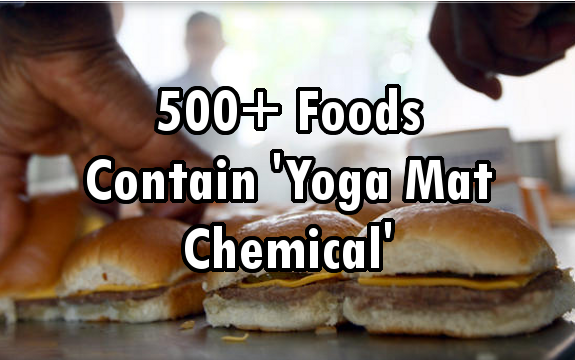Banned in Other Countries, ‘Yoga Mat Chemical’ Found in 500 U.S. Foods

 A chemical recently removed by Subway due to a key blogger (Food Babe) and consumer outrage, azodicarbonamide (ADA for short) is a chemical is found in everything from yoga mats and flip-flops to bagels and tortillas. Though while Subway recently made headlines when they announced they would stop using the chemical in their breads, the toxic chemical is still found in nearly 500 U.S. foods, according to a report from the Environmental Working Group.
A chemical recently removed by Subway due to a key blogger (Food Babe) and consumer outrage, azodicarbonamide (ADA for short) is a chemical is found in everything from yoga mats and flip-flops to bagels and tortillas. Though while Subway recently made headlines when they announced they would stop using the chemical in their breads, the toxic chemical is still found in nearly 500 U.S. foods, according to a report from the Environmental Working Group.
ADA was approved for use by the FDA in 1962, according to Businessweek. It was a substitute for the newly banned dough conditioner potassium bromate in California after it was identified as potentially carcinogenic. Since then, ADA has inundated the U.S. food supply.
The Environmental Working Group (EWG) recently released a report indicating nearly 500 foods on U.S. grocery store shelves include ADA. It’s used as a flour bleaching agent and to improve oxidation to assist in the baking process. But it’s also used to improve the elasticity of plastics in things like shoes and yoga mats.
As Reuters reports, ADA is approved for use in the U.S. and Canada, but is banned in Australia and some European countries.
The World Health Organization (WHO) says studies on the safety of ADA have indicated there is “abundant evidence that azodicarbonamide can induce asthma, other respiratory symptoms, and skin sensitization” in people who work with it.
The Center for Science in the Public Interest explains that when ADA is baked, it undergoes changes that could make it even more dangerous. When baked, ADA forms semicarbazide and urethane—both of which have been linked to cancer in mice.
So why is it still being used in U.S. foods?
The FDA stands by their position that ADA is safe in quantities less than 0.0045 percent of the weight of flour used in a product. And companies using ADA seem to believe the organization despite ADA being unnecessary due to the presence of alternatives.
Critics of the wave against ADA say it’s not included on the longest lists of possible carcinogens and that urethane is found in bread even when it’s not made with ADA.
John Coupland of Penn State remarked, “Toasting bread doubles or triples the urethane content, a much greater increase than adding azodicarbonamide, but no one is arguing we should ban toasters because of that.”
Coupland is right—there are many dangers in the U.S. food supply and choosing ADA as the current target may be only the result of media hype. However, consumers want simple products and they want foods that don’t pose health risks. Is it really too much to ask food producers to use fewer ingredients or safe alternatives?
Subway’s decision to stop using ADA came after Food Babe started a petition against it. It could take similar consumer action to stop these other companies from baking with it.
Sign up to the Natura lSociety newsletter to receive a free report on other dangerous, hidden food additives.

What people need to realize is that ADA wasn’t found in “foods” – it was found in “food-like substances” where it seems that anything goes. Real food is stuff that comes directly from nature – not from a factory.